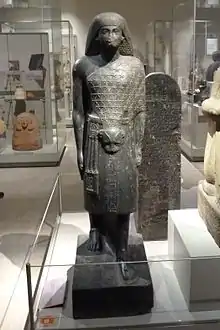Anen
Anen or Aanen was an ancient Egyptian official during the late 18th Dynasty of Egypt.
| Anen | |
|---|---|
 Statue of Anen in Turin, Museo Egizio[1] | |
| Successor | Simut |
| Dynasty | 18th Dynasty |
| Pharaoh | Amenhotep III |
| Father | Yuya |
| Mother | Tjuyu |
| Burial | TT120 |
Biography
| Anen in hieroglyphs |
|---|
He was the son of Yuya and Tjuyu and the brother of Queen Tiye, the wife of Pharaoh Amenhotep III. Under the rule of his brother-in-law, Anen became the Chancellor of Lower Egypt, Second Prophet of Amun, and sem-priest of Heliopolis, and acquired the title Divine Father.[2]
A surviving statue of Anen is now in the Museo Egizio, Turin (Inv. No. 5484 / Cat. 1377). A shabti of his is now in The Hague. Inscriptions on Anen's own monuments do not mention that he was Amenhotep III's brother-in-law.[3] However, this relationship is established by a short but clear reference to him in his mother Tjuyu's coffin, which stated that her son Anen was the second prophet of Amun.[4]
It is likely that he died before Year 30 of Amenhotep III, since he is not mentioned in texts relating to the pharaoh's Sed festival;[5] in the last decade of Amenhotep's reign another man, Simut, took over Anen's place as Second Prophet of Amun. Simut had been Fourth Prophet of Amun previously.
Anen was buried in his tomb (TT120) in the Theban Necropolis, on the west bank of the Nile opposite Thebes. His son and four daughters are depicted in his tomb, but their names have not survived.[2][6]
References
- Statua di Anen, secondo sacerdote di Amon
- Aidan Dodson & Dyan Hilton, The Complete Royal Families of Ancient Egypt, (London: Thames & Hudson, 2004) ISBN 0-500-05128-3, p. 157
- David O'Connor & Eric Cline, Amenhotep III: Perspectives on his reign, University of Michigan Press, 1998, p. 6
- O'Connor & Cline, pp. 5–6
- Aldred: Akhenaten, p. 220
- But there is to say it is not clear where Dodson / Hilton have there informations from. The last Egyptologist (Lyla Pinch-Brock) working in the tomb found no advice for these children. There is also no mention in the diaries by Norman de Garis Davies.
